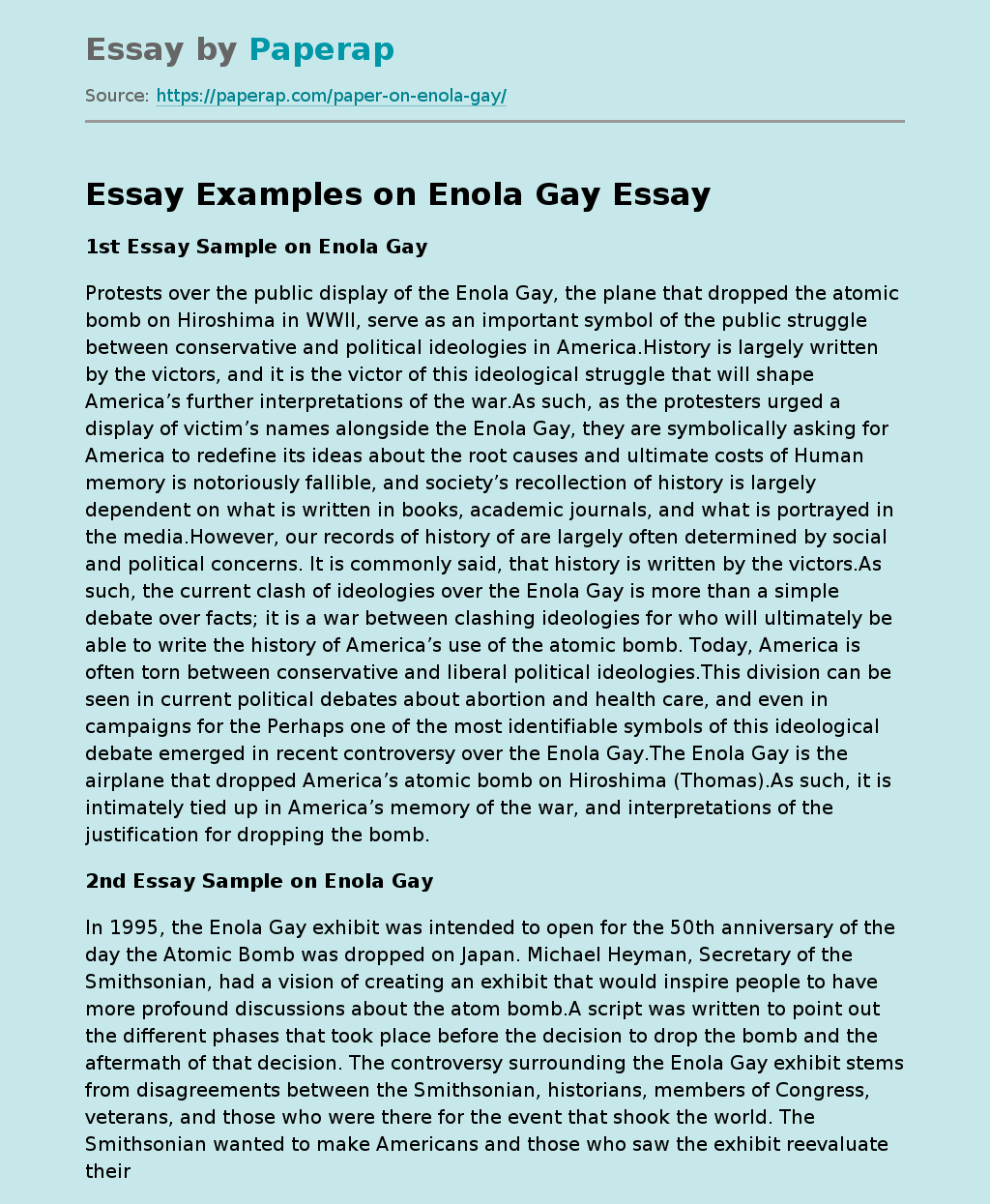What is Enola Gay?
The next example is an essay on “What is Enola Gay?” tells about the strategic bomber model B-29, which on August 6, 1945 dropped the world’s first nuclear bomb on the Japanese city of Hiroshima at the end of World War II.
Protests over the public display of the Enola Gay, the plane that dropped the atomic bomb on Hiroshima in WWII, serve as an important symbol of the public struggle between conservative and political ideologies in America.History is largely written by the victors, and it is the victor of this ideological struggle that will shape America’s further interpretations of the war.
As such, as the protesters urged a display of victim’s names alongside the Enola Gay, they are symbolically asking for America to redefine its ideas about the root causes and ultimate costs of Human memory is notoriously fallible, and society’s recollection of history is largely dependent on what is written in books, academic journals, and what is portrayed in the media.
However, our records of history of are largely often determined by social and political concerns. It is commonly said, that history is written by the victors.As such, the current clash of ideologies over the Enola Gay is more than a simple debate over facts; it is a war between clashing ideologies for who will ultimately be able to write the history of America’s use of the atomic bomb. Today, America is often torn between conservative and liberal political ideologies.
This division can be seen in current political debates about abortion and health care, and even in campaigns for the Perhaps one of the most identifiable symbols of this ideological debate emerged in recent controversy over the Enola Gay.
The Enola Gay is the airplane that dropped America’s atomic bomb on Hiroshima (Thomas).As such, it is intimately tied up in America’s memory of the war, and interpretations of the justification for dropping the bomb.
In 1995, the Enola Gay exhibit was intended to open for the 50th anniversary of the day the Atomic Bomb was dropped on Japan. Michael Heyman, Secretary of the Smithsonian, had a vision of creating an exhibit that would inspire people to have more profound discussions about the atom bomb.A script was written to point out the different phases that took place before the decision to drop the bomb and the aftermath of that decision.
The controversy surrounding the Enola Gay exhibit stems from disagreements between the Smithsonian, historians, members of Congress, veterans, and those who were there for the event that shook the world. The Smithsonian wanted to make Americans and those who saw the exhibit reevaluate their understanding of World War II. Those who opposed the exhibit, however, were concerned with the credibility and the message it was trying to send.
The question was whether the Smithsonian Institution’s exhibition of Enola Gay was non-biased, or if, instead, it was intended as an instrument of propaganda.This dispute and various other events led to the controversy over the Enola Gay exhibit and its eventual cancellation. The exhibition was supposed to contain five controversial narrative sections. Thefirst section was to deal with Japanese invasions and the attack on Pearl Harbor.
The next would explain the decision to drop the Atomic Bomb.The third was to focus on the handling of the bomb from the secret factories to the loading onto the plane.The fourth section was intended to reveal the horrible destruction of Hiroshima and Nagasaki after they were bombed, and the final section of the exhibition was scheduled to discuss the problems of nuclear weapons and the arms race that followed the war. To the Smithsonian, the Enola Gay was instrumental in events that changed our world.
What is Enola Gay?. (2019, Oct 10). Retrieved from https://paperap.com/paper-on-enola-gay/

